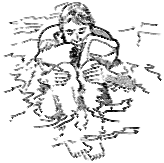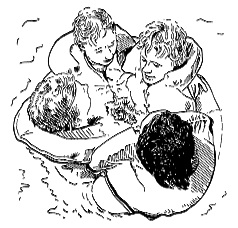Cold Water Survival
This task is about getting information from a text.
A person who finds him or herself in cold water should not remove any clothing, except for a heavy item such as an overcoat.
A person wearing a life jacket can increase survival time by using the Heat Escape Lessening Position (HELP). This is where the knees are bent and drawn towards the chest, and the arms are pressed firmly against the sides of the chest. This position delays heat loss by protecting the most vulnerable areas: the head, the sides of the chest, and the groin.
In rough, cold water, an average swimmer without a life jacket should not swim a distance greater than one-tenth of his or her swimming ability. If the swimmer is close to the wreckage of a boat, he or she should attempt to climb onto the boat and should maintain warmth by tucking themselves into a ball.
The 'huddle' position is based on the same principle as the HELP position and was developed for groups of three or more people. The sides of the chest, the groin, and the lower body are pressed together. This formation is particularly useful if small children are involved, as they can be supported, protected, and warmed in the centre of the group.
If swimmers must stay in deep water without a life jacket for a long period, they should remain as still as possible, conserving energy and, if possible, staying in a tucked position. As the bodies core temperature drops, it will become increasingly difficult for swimmers to make sensible decisions. Purposeful muscle movements (e.g., swimming or holding onto a boat) become difficult, and people may be unaware of their situation.
A person with a extremely low body temperature (hypothermia) must always be handled very gently and re-warmed slowly. If the person is conscious, do the following:
- Remove the person from the water.
- Shelter him or her from the wind and rain immediately.
- Create a sheltered, warm, dry place.
- Remove wet clothing and wrap the person in blankets, space blankets, or a sleeping bag.
- Huddle together for warmth so body temperature can rise gradually.
- Give the person warm, sweet drinks.
- Seek medical aid.
Do not do any of the following:
- Apply excessive external heat (e.g., fire or an electric blanket) to the person's body.
- Massage the person's arms and legs.
- Give them alcohol.
- Move them.
Source: Teaching Swimming and Water Safety, Aust Swim, 2001. (Text amended and abridged.)



